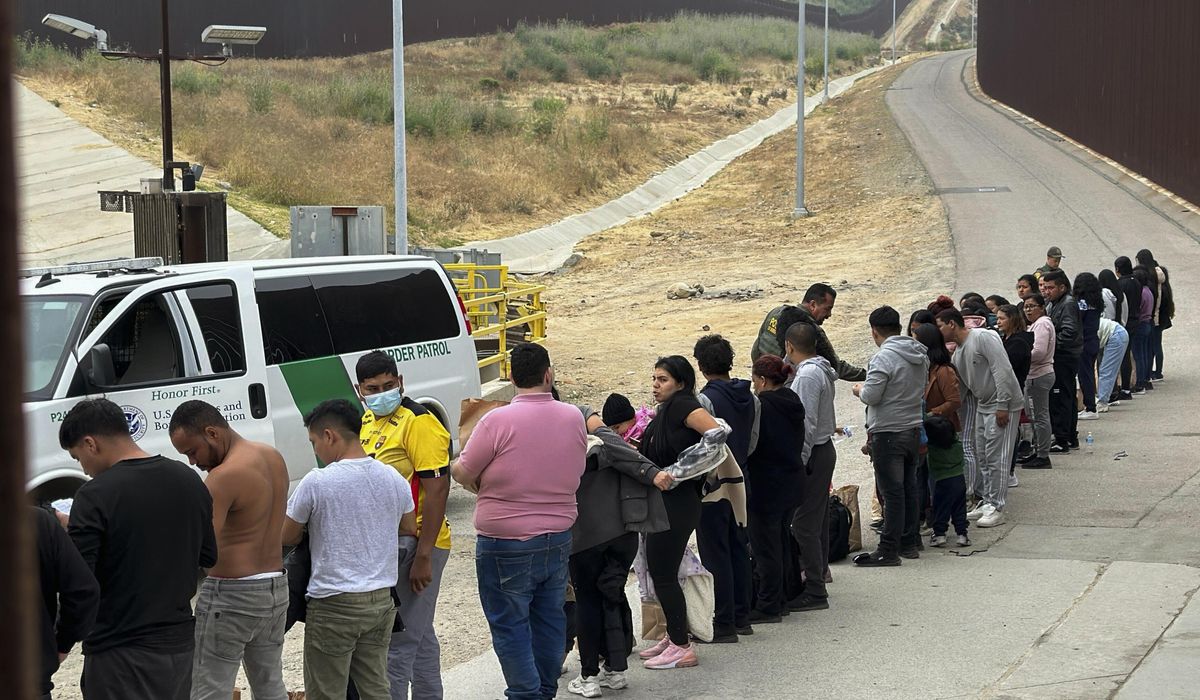


It sounded like any other border chase. A Ford F-150 took off down a dirt road in southeastern Arizona, fleeing Border Patrol agents, then finally ditched the truck in an orchard, and everyone ran off.
But when agents tracked down the driver and the migrants who fled the truck, they got their surprise: Jose Alberto Lopez-Santiago, one of three Mexican migrants who’d been in the F-150, said he was being charged $80,000 to be smuggled into the U.S.
A day after that June 9 incident, Border Patrol agents in southwestern Arizona chased down a Toyota Sienna packed with 12 people, who turned out to be illegal immigrants from Mexico and Guatemala. One of them, Maria Juarez-Lopez, told agents she paid $50,000 to a coordinator in Agua Prieta, Mexico, to be smuggled to San Diego.
Last week, agents working near Sonoita, in the middle of Arizona’s border with Mexico, pulled two illegal immigrants out of the trunk of a Chevrolet Malibu in 100-degree heat. One of the migrants, from Guatemala, said he had already paid 50,000 Quetzals and owed 725,000 more when he got to Mississippi — which works out to nearly $100,000 in U.S. currency.
Those are rates that, in the past, were paid by migrants from far-flung places such as China or Vietnam. Now, they are being paid by people in America’s backyard.
In the weeks since President Biden announced his new border reset, prices paid at the border have increased, according to The Washington Times’ database of border smuggling cases.
Before Mr. Biden’s June 4 announcement, Mexican migrants caught as they were being smuggled deeper into the U.S. were paying an average of about $9,400. Those from Central America’s Northern Triangle were spending about $13,900.
In the roughly two weeks after the announcement, Mexicans said their smuggling costs averaged $10,100, and those from El Salvador, Honduras, and Guatemala said they were expecting to pay about $14,800.
“It’s a business,” said Emilio Gonzalez, who ran U.S. Citizenship and Immigration Services in the Bush administration. “The Biden border crisis is a business and everybody makes money except the U.S. taxpayer. It’s a human trafficking business and the Biden administration is the biggest supporter of this human trafficking business.”
The data comes from court documents filed by Customs and Border Protection or U.S. Immigration and Customs Enforcement authorities in prosecutions against smugglers. Agents and officers, in investigating cases, often get migrants to reveal how much they paid, then report that data to the courts as evidence justifying the smuggling arrests and detention of the migrants as material witnesses.
The $80,000 and $100,000 price tags are so high that some experts question whether the figures are real. They speculated that migrants might be lying to the agents.
The data shows something is going on. The Times database includes seven years of data going back to the Trump administration’s zero-tolerance policy, and in that time, there has never been as much variation in the rates migrants say they are being charged.
Experts told The Times that there’s not much science to the payments, and cartels charge whatever they think they can get out of migrants.
“My theory is that those smuggled/material witnesses that pay so much are probably of means,” Ronald Vitiello, a former chief of the Border Patrol, said in an email. “Like a kidnap victim in Mexico is ransomed for a lot more if they own a business/property.”
He said another possibility is that they are criminals who were expected to pay off the debt by working within the cartel’s operations.
Among the smuggling cases filed with courts in recent weeks were:
• A June 14 arrest at a highway checkpoint near Falfurrias, Texas, where a canine trained to sniff out people or drugs alerted to a Dodge pickup.
When agents searched, they found two illegal immigrants who’d been stuffed inside the rear passenger seat with their heads sticking up through holes cut in the upholstery, concealed by a pile of trash and clothing. The man accused in that incident had been arrested by Texas authorities on smuggling charges a month before. He told Border Patrol agents he makes $1,000 per person.
• A June 11 arrest, also at the Falfurrias checkpoint, where agents thought a truck driver’s responses were too quick. They searched the refrigerated trailer and found 42 illegal immigrants tucked in among rotting produce.
The migrants were from Ecuador, Guatemala, El Salvador, Honduras and Mexico. A Homeland Security Investigations agent said one of the truck drivers, who’d been arrested in April for another smuggling case, said they were getting $20,000 to run the migrants from the border up to Houston.
• A June 17 arrest of a Nicaraguan man whom agents said was nabbed while waiting to pick up illegal immigrants. The man was here on “parole,” one of millions of illegal immigrants caught and released by the Biden administration. He said he started smuggling after seeing an ad on TikTok offering big money to smuggled migrants, and he was going to be paid up to $4,000 for this run.
Recruiting smugglers on TikTok and Instagram has become commonplace over the last year, joining Facebook and Craigslist postings as popular advertising spots.
Drivers can make a few hundred dollars to shuttle migrants locally at the border, or $1,000 per person if they are making a longer run up to one of the major cities, such as Houston, Phoenix or Los Angeles.
Drivers aren’t the only ones getting paid.
Stash house operators, foot guides and coordinators all take their cut, as do the cartels themselves.
Border Patrol agents in Arizona often report to the courts the smuggling fees migrants pay plus an additional “mafia fee” or “piso,” which is the fee nearly every migrant pays to smuggling cartels for the use of their routes into the U.S.
A standard mafia fee in recent weeks has been 25,000 pesos, or about $1,350.
• Stephen Dinan can be reached at sdinan@washingtontimes.com.
